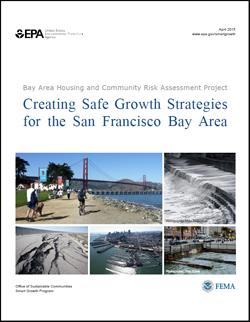Risks from earthquakes and sea level rise to communities in the San Francisco Bay Area will increase in the future, as the Bay Area's population is projected to grow from 7 million to 9 million by 2040. Furthermore, approximately 80 percent of the Bay Area's future housing needs (as well as 66 percent of new jobs) will be accommodated in Priority Development Areas identified in Plan Bay Area, the region's long-range plan.

Many of these areas of anticipated growth, particularly those along the Bay shoreline, are at risk from earthquakes and sea level rise. In the wake of a major disaster, homes in the region will likely be seriously damaged and residents displaced. Elderly people, low-income residents, people without automobiles, and renters are particularly vulnerable because they might lack access to information and services, financial means, or physical capacity to prepare for, respond to, and recover from hazard events.
The Association of Bay Area Governments requested help from EPA's Smart Growth Implementation Assistance Program to help incorporate resilience to natural hazards and climate change into regional and local land use planning, decision-making, and implementation. EPA partnered with the Federal Emergency Management Agency (FEMA) on this project.
The project team developed strategies that can help reduce the vulnerability of development in the Bay Area so that all growth is not only smart, but also safe. The project included two major phases:
- Vulnerability assessment: The project team examined both housing vulnerability and community vulnerability. The team identified the characteristics of Bay Area housing and communities that increase their vulnerability to earthquakes and flooding and identified and assessed housing and community vulnerability at regional and community scales.
- Strategy development: The team developed 40 strategies that reduce housing and community vulnerability to help the region meet its resilience, sustainability, prosperity, and equity goals.
The goal was to create a new set of safe growth strategies that would increase regional resilience and ensure that people could either stay in their homes or return to their homes more quickly after disasters. The safe growth strategies are also designed to ensure that local development is affordable, transit-accessible, and beneficial to the economy and environment.
The Association of Bay Area Governments is promoting these strategies through its Resilience Program, Exit with resources to help communities take actions at the local level that will help the entire region become more resilient in the face of earthquakes and flooding.
Creating Safe Growth Strategies for the San Francisco Bay Area (2015) strives to show that communities can plan for growth that meets residents' everyday needs while also making them safer from natural hazards. The project also provides a model other regions or communities could use to assess the vulnerability of their housing and residents and develop strategies to make development safer.
Learn more about smart growth strategies for disaster resilience and recovery.
You will need Adobe Reader to view some of the files on this page. See EPA’s About PDF page to learn more.- Creating Safe Growth Strategies for the San Francisco Bay Area (PDF)(75 pp, 10 MB, 2015)
